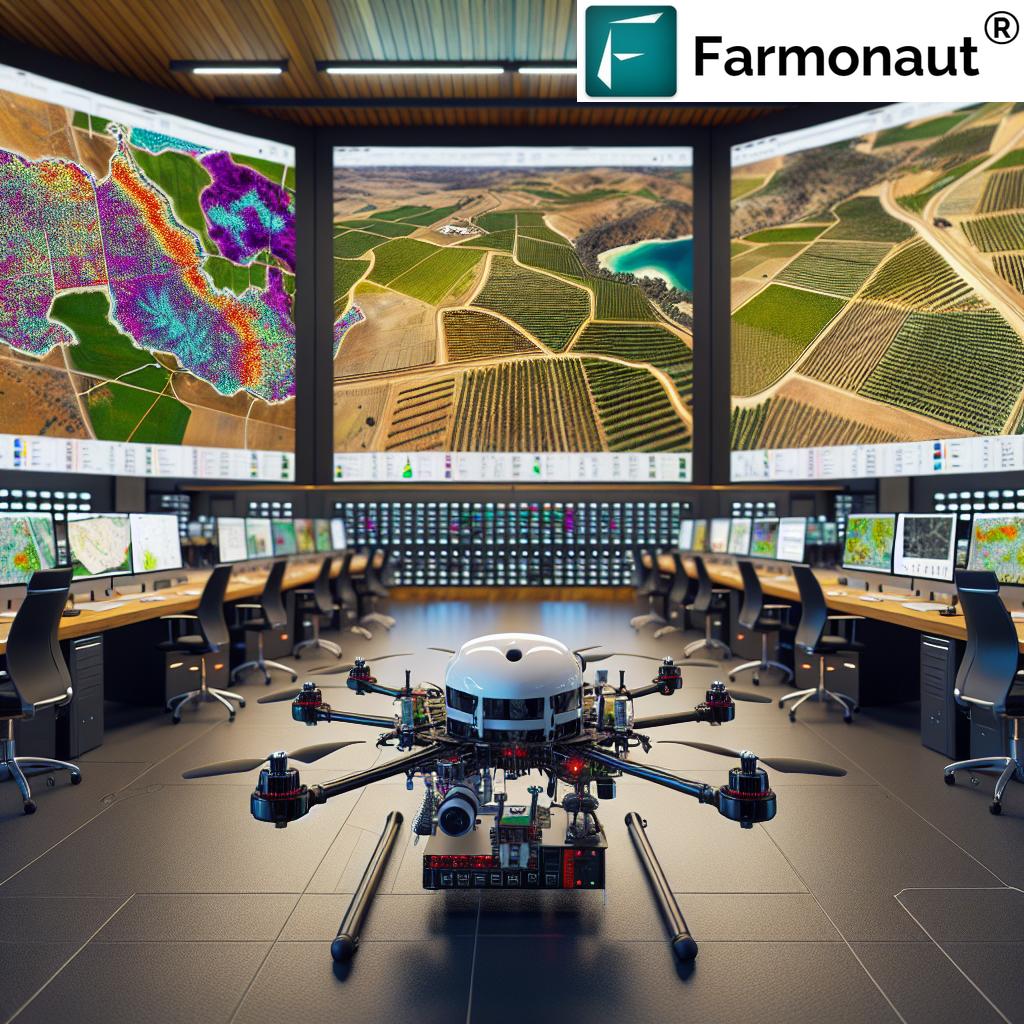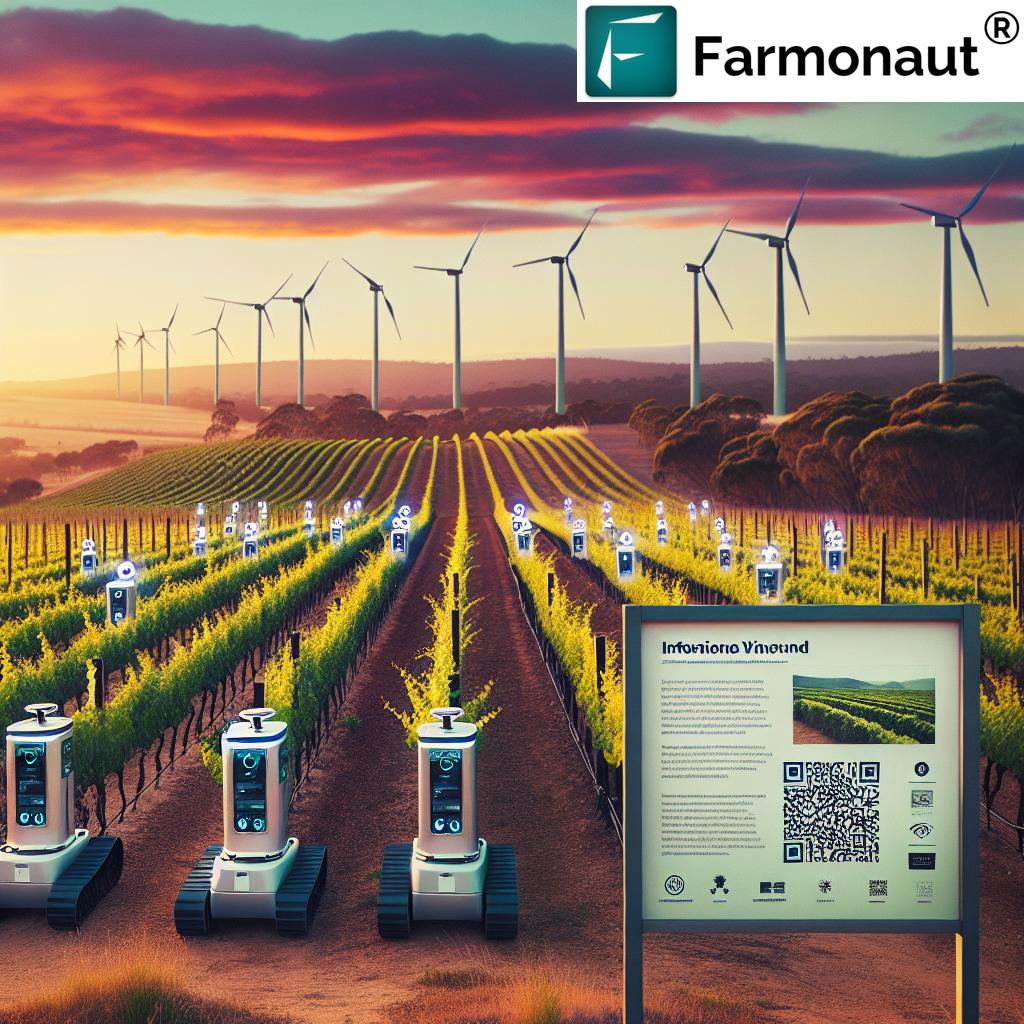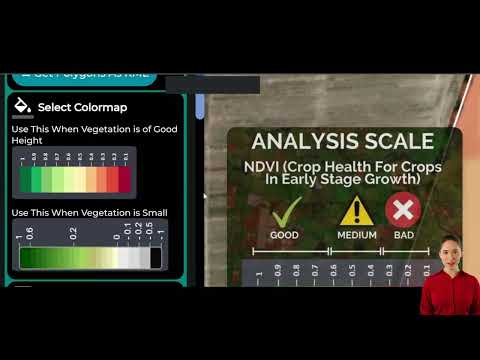Revolutionizing Australian Wine Exports: How GIS and AgTech are Shaping Sustainable Viticulture Practices
“Australian wineries using GIS technology have seen up to 30% increase in grape yield and quality over traditional methods.”
Welcome to our comprehensive exploration of the Australian wine industry’s transformation through cutting-edge technologies and sustainable practices. In this blog, we’ll delve into how Geographical Information Systems (GIS) and agricultural technology (AgTech) are revolutionizing viticulture and shaping the future of Australian wine exports.

The Evolution of Australian Wine Exports
The Australian wine sector has long been a significant player in the global market. However, in recent years, we’ve witnessed a remarkable shift towards more sustainable and technologically advanced winegrowing practices. This evolution is not just about producing better wine; it’s about ensuring the long-term viability of the industry in the face of climate change and increasing international competition.
- Adoption of sustainable winegrowing practices
- Integration of GIS and AgTech solutions in vineyard management
- Focus on wine tourism promotion to diversify income streams
- Emphasis on organic wine production and climate-resilient grape varieties
As we navigate these changes, companies like Farmonaut are at the forefront, offering innovative solutions that align perfectly with the needs of modern viticulture. Let’s explore how these advancements are shaping the industry.
GIS in Viticulture: A Game-Changer for Australian Wineries
Geographical Information Systems have become indispensable tools in modern viticulture. These sophisticated systems allow winemakers to map and analyze various aspects of their vineyards with unprecedented precision.
Key Applications of GIS in Viticulture:
- Soil Mapping: GIS helps in creating detailed soil maps, enabling winemakers to understand the terroir better and make informed decisions about grape variety selection and planting strategies.
- Micro-climate Analysis: By integrating weather data, GIS can identify micro-climates within vineyards, crucial for optimizing grape growing conditions.
- Irrigation Management: GIS-based systems can monitor soil moisture levels and help in implementing precise irrigation strategies, conserving water resources.
- Pest and Disease Management: Early detection of pest infestations or disease outbreaks is possible through GIS, allowing for targeted interventions.
Farmonaut’s satellite-based crop health monitoring system exemplifies the power of GIS in viticulture. By providing real-time data on vegetation health (NDVI) and soil moisture levels, Farmonaut enables Australian winemakers to make data-driven decisions that optimize grape quality and yield.
Sustainable Winegrowing Practices: The Future of Australian Viticulture
Sustainability is no longer just a buzzword in the Australian wine industry; it’s becoming a fundamental aspect of vineyard management and winemaking processes. The adoption of sustainable practices is driven by both environmental concerns and market demands for eco-friendly products.
Key Sustainable Practices in Australian Viticulture:
- Water Conservation: Implementing drought-resistant grape varieties and efficient irrigation systems.
- Organic Farming: Reducing the use of synthetic pesticides and fertilizers in favor of organic alternatives.
- Carbon Footprint Reduction: Adopting renewable energy sources and minimizing emissions in wine production and transportation.
- Biodiversity Enhancement: Creating wildlife corridors and promoting native vegetation in and around vineyards.
Farmonaut’s carbon footprinting feature aligns perfectly with these sustainability goals. By providing real-time data on emissions, it allows Australian wineries to track and reduce their environmental impact, contributing to more sustainable viticulture practices.
Explore Farmonaut’s API for advanced vineyard management
AgTech Solutions Transforming Australian Wineries
The integration of agricultural technology in Australian wineries is ushering in a new era of precision viticulture. These innovative tools are helping winemakers optimize every aspect of their operations, from planting to harvest.
Cutting-Edge AgTech Solutions in Viticulture:
- Drone Technology: Used for aerial mapping and monitoring of vineyards.
- IoT Sensors: Providing real-time data on soil conditions, temperature, and humidity.
- AI-Powered Predictive Analytics: Forecasting yield, harvest dates, and potential issues.
- Robotic Pruning and Harvesting: Increasing efficiency and reducing labor costs.
Farmonaut’s Jeevn AI Advisory System exemplifies the power of AI in viticulture. By analyzing satellite data and other inputs, it provides personalized advice on crop management, helping Australian winemakers make informed decisions that improve productivity and efficiency.
Wine Labelling Regulations and Export Documentation
Navigating the complex world of wine labelling regulations and export documentation is crucial for Australian wineries looking to expand their global reach. Compliance with these regulations ensures smooth entry into international markets and builds trust with consumers.
Key Aspects of Wine Labelling and Export Documentation:
- Geographic Indications (GIs): Ensuring accurate representation of wine origin.
- Alcohol Content Labelling: Meeting specific requirements for different export markets.
- Health Warnings: Adhering to varying international standards for health-related information on labels.
- Export Certificates: Obtaining necessary documentation for customs clearance in target countries.
Farmonaut’s blockchain-based traceability solutions can play a significant role in ensuring transparency and authenticity in the wine supply chain, potentially streamlining the export documentation process.
Access Farmonaut’s API Developer Docs for advanced integration
Global Wine Marketing Strategies for Australian Exports
To thrive in the competitive global wine market, Australian wineries need to adopt sophisticated marketing strategies that highlight their unique selling points and appeal to international consumers.
Effective Global Wine Marketing Approaches:
- Digital Presence: Leveraging social media and e-commerce platforms to reach global audiences.
- Virtual Tastings: Offering online wine tasting experiences to engage international customers.
- Sustainability Storytelling: Highlighting eco-friendly practices to appeal to environmentally conscious consumers.
- Collaborative Promotions: Partnering with local food and tourism industries in target markets.
Farmonaut’s data-driven insights can contribute to these marketing efforts by providing verifiable information on sustainable practices and vineyard management, enhancing the storytelling aspect of Australian wine brands.

“Sustainable viticulture practices have helped reduce water usage in Australian vineyards by an average of 25% in the last decade.”
Wine Tourism Promotion: A Key Driver for Australian Exports
Wine tourism has become an integral part of the Australian wine industry, offering a unique way to promote exports and build brand loyalty among international visitors.
Strategies for Enhancing Wine Tourism:
- Immersive Vineyard Experiences: Offering tours that showcase sustainable practices and technology use.
- Food and Wine Pairing Events: Collaborating with local chefs to create unique gastronomic experiences.
- Virtual Reality Tours: Providing remote experiences for potential customers unable to visit in person.
- Educational Programs: Hosting workshops on winemaking, viticulture, and sustainability.
Farmonaut’s satellite imagery and data visualization tools could be integrated into these tourism experiences, offering visitors a high-tech perspective on modern viticulture practices.
Climate-Resilient Grape Varieties: Adapting to Changing Conditions
As climate change continues to impact wine regions globally, Australian winemakers are turning to climate-resilient grape varieties to ensure the long-term sustainability of their industry.
Promising Climate-Resilient Varieties for Australian Viticulture:
- Tempranillo: A Spanish variety known for its heat tolerance and early ripening.
- Fiano: An Italian white grape variety that thrives in warmer climates.
- Nero d’Avola: A Sicilian red variety that performs well in hot, dry conditions.
- Vermentino: A drought-resistant white variety gaining popularity in Australia.
Farmonaut’s AI-driven insights can assist in identifying optimal planting locations for these new varieties, based on soil conditions and micro-climate data.
Organic Wine Production: Meeting Growing Global Demand
The demand for organic wines is surging worldwide, presenting a significant opportunity for Australian winemakers. Organic viticulture not only aligns with sustainability goals but also appeals to health-conscious consumers.
Key Aspects of Organic Wine Production:
- Natural Pest Control: Using beneficial insects and companion planting instead of synthetic pesticides.
- Organic Fertilization: Employing compost and cover crops to enrich soil naturally.
- Minimal Intervention Winemaking: Reducing the use of additives and preservatives in the winemaking process.
- Certification Processes: Navigating the complexities of organic certification for different export markets.
Farmonaut’s satellite monitoring can play a crucial role in organic vineyard management by providing early detection of pest and disease issues, enabling timely organic interventions.
Wine Quality Standards and Shipping Regulations
Maintaining high quality standards and adhering to international shipping regulations are paramount for successful wine exports. Australian winemakers must navigate a complex landscape of requirements to ensure their products reach global markets in optimal condition.
Critical Factors in Wine Quality and Shipping:
- Temperature Control: Implementing advanced temperature monitoring systems during transportation.
- Packaging Innovations: Developing eco-friendly packaging that ensures wine quality during long-distance shipping.
- Quality Assurance Programs: Implementing rigorous testing protocols to meet international standards.
- Compliance with Import Regulations: Staying updated on changing import laws in key markets like China, Europe, and the Americas.
Farmonaut’s blockchain-based traceability solutions can provide valuable support in maintaining transparency throughout the supply chain, potentially simplifying compliance with international regulations.
Emerging Trends: Low-Alcohol Wines and Innovative Blends
The global wine market is witnessing a shift towards lower alcohol options and unique blends, presenting both challenges and opportunities for Australian winemakers.
Trends Shaping the Future of Wine Production:
- Low-Alcohol Wines: Developing techniques to produce flavorful wines with reduced alcohol content.
- Alternative Fermentation Methods: Exploring new ways to control alcohol levels during winemaking.
- Innovative Blending Techniques: Creating unique flavor profiles by blending traditional and emerging grape varieties.
- Alcohol-Free Options: Expanding product lines to include non-alcoholic wines to capture a growing market segment.
Farmonaut’s data analytics can assist winemakers in identifying optimal harvest times and conditions to achieve desired alcohol levels and flavor profiles in their wines.
The Role of Research and Innovation in Australian Viticulture
Continuous research and innovation are vital for maintaining Australia’s competitive edge in the global wine market. Collaboration between academic institutions, industry bodies, and technology providers is driving advancements in viticulture and winemaking.
Key Areas of Research and Innovation:
- Genetic Research: Developing new grape varieties resistant to pests and climate change.
- Precision Viticulture: Advancing technologies for ultra-precise vineyard management.
- Sustainable Winemaking: Innovating processes to reduce water and energy consumption in wineries.
- Flavor Profiling: Utilizing advanced sensory science to understand and enhance wine flavors.
Farmonaut’s commitment to continuous improvement in their satellite monitoring and AI advisory systems aligns well with the industry’s focus on research and innovation.
Comparison: Traditional vs. Farmonaut-Enabled Viticulture Practices
| Viticulture Aspect | Traditional Methods | Farmonaut Satellite System |
|---|---|---|
| Irrigation Management | Manual checks, periodic soil sampling | Real-time soil moisture monitoring, 20-30% water savings |
| Pest and Disease Detection | Regular field scouting | Early detection up to 7 days earlier via satellite imagery |
| Harvest Timing | Based on experience and manual testing | Data-driven decision making using vegetation indices |
| Yield Estimation | Manual cluster counting and sampling | 90-95% accuracy using AI and satellite data analysis |
| Sustainability Monitoring | Periodic assessments, often subjective | Continuous monitoring of environmental impact and resource use |
Farmonaut Subscriptions for Vineyard Management
Frequently Asked Questions
Q: How is GIS technology improving Australian wine production?
A: GIS technology enhances vineyard management by providing precise data on soil conditions, micro-climates, and crop health, leading to optimized grape quality and yield.
Q: What are the main challenges facing Australian wine exports?
A: Key challenges include climate change impacts, increasing global competition, changing consumer preferences, and navigating complex international regulations.
Q: How are sustainable practices benefiting Australian wineries?
A: Sustainable practices are reducing environmental impact, lowering production costs, and meeting growing consumer demand for eco-friendly wines, thus enhancing market competitiveness.
Q: What role does wine tourism play in Australian wine exports?
A: Wine tourism boosts brand recognition, creates direct-to-consumer sales channels, and enhances the overall image of Australian wines in international markets.
Q: How is AgTech improving vineyard pest management?
A: AgTech solutions like Farmonaut’s satellite monitoring enable early detection of pest issues, allowing for targeted and timely interventions, reducing the need for broad-spectrum pesticides.
Conclusion: The Future of Australian Wine Exports
As we’ve explored throughout this blog, the Australian wine industry is at the forefront of a technological and sustainable revolution. The integration of GIS, AgTech solutions, and sustainable practices is not just enhancing the quality and consistency of Australian wines but also positioning the industry for long-term success in the global market.
The adoption of innovative technologies like Farmonaut’s satellite-based farm management solutions is enabling winemakers to make more informed decisions, optimize resource use, and adapt to changing climate conditions. These advancements, coupled with a strong focus on sustainability and quality, are setting new standards in viticulture and winemaking.
As the industry continues to evolve, we can expect to see even greater integration of technology in all aspects of wine production and marketing. From AI-driven vineyard management to blockchain-enabled traceability, the future of Australian wine exports looks bright, innovative, and sustainable.
By embracing these technological advancements and sustainable practices, Australian winemakers are not just producing exceptional wines; they’re crafting a legacy of innovation and environmental stewardship that will resonate with consumers around the world for generations to come.






